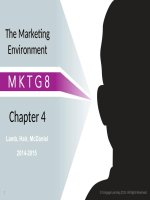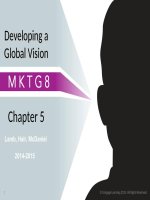Principles of marketing MKTG 8e joe hair carl mcdaniel chapter 017
Bạn đang xem bản rút gọn của tài liệu. Xem và tải ngay bản đầy đủ của tài liệu tại đây (601.72 KB, 35 trang )
Personal
Selling and
Sales
Management
Chapter 17
Lamb, Hair, McDaniel
2014-2015
1
© Cengage Learning 2015. All Rights Reserved.
1
Describe personal selling
2
Discuss the key differences between
relationship selling and traditional selling
3
Describe customer relationship management
4
List the steps in the selling process
5
Describe the functions of sales management
© Cengage Learning 2015. All Rights Reserved
2
Personal Selling
Describe Personal
Selling
3
1
© Cengage Learning 2015. All Rights Reserved
Advantages of
Personal Selling
Personal selling provides detailed explanation or
demonstration of the product.
Message can be varied according to motivations of
each customer.
Personal selling can be directed only to qualified
prospects.
Costs can be controlled by adjusting the size of the
sales force in one-person increments.
Personal selling is considerably more effective than
other forms of promotion in obtaining a sale and
gaining a satisfied customer.
1
© Cengage Learning 2015. All Rights Reserved
4
Exhibit 17.1
Comparison of Personal Selling and
Advertising/Sales Promotion
Personal selling is important
if…
Advertising and sales
promotion are more
important if…
The product has a high value.
The product has a low value.
It is a custom-made product.
It is a standardized product.
There are few customers.
There are many customers.
The product is technically
complex
The product is easy to
understand.
Customers are concentrated
Customers are geographically
dispersed.
Examples: Insurance policies,
custom windows, airplane
engines
Examples: Soap, magazine
subscriptions, cotton t-shirts
© Cengage Learning 2015. All Rights Reserved
5
Relationship Selling
Discuss the key
differences between
relationship selling and
traditional selling
6
2
© Cengage Learning 2015. All Rights Reserved
Relationship Selling
Relationship selling, or
consultative selling, is a sales
practice that involves building,
maintaining, and enhancing
interactions with customers in
order to develop long-term
satisfaction through mutually
beneficial partnerships.
2
© Cengage Learning 2015. All Rights Reserved
7
Exhibit 17.2
Key Differences between Traditional Selling and Relationship Selling
Traditional Personal Selling
Relationship or Consultative Selling
Sell products (goods and services)
Sell advice, assistance, and counsel
Focus on closing sales
Focus on improving the customer’s bottom
line
Limited sales planning
Consider sales planning as top priority
Spend most contact time telling customers
about product
Spend most contact time attempting to build a
problem-solving environment with the
customer
Conduct “product-specific” needs assessments Conduct discover in the full scope of the
customer’s operations
“Lone wolf” approach to the account
Team approach to the account
Proposals and presentations based on pricing
and product features
Proposals and presentations based on profit
impact and strategic benefits to the customer
Sales follow-up is short term, focused on
product delivery
Sales follow-up is long term, focused on longterm relationship enhancement
SOURCE: Robert M. Peterson, Patrick Schul, and George H. Lucas, Jr., “Consultative Selling: Walking the Walk in the New Selling
Environment,” National Conference on Sales Management Proceedings, March 1996.
© Cengage Learning 2015. All Rights Reserved
8
Customer Relationship Management
and Personal Selling
Describe customer
relationship
management
9
© Cengage Learning 2015. All Rights Reserved
3
Customer Relationship
Management
Identify customer relationships
Understand interactions of the
customer base
Capture customer data
Leverage customer information
3
© Cengage Learning 2015. All Rights Reserved
10
Identify Customer
Relationships
Companies that have CRM systems:
•Follow a customer-centric focus or
model
•Use knowledge management systems
• Organize information gathered
through the “learning” process
• Learn via interactions
3
© Cengage Learning 2015. All Rights Reserved
11
Interactions of the Current
Customer Base
CRM is built on interactions between
customers and organizations.
•Touch points occur at a wide variety
of locations.
– Web-based interactions are an
increasingly popular.
– One popular touch point is the pointof-sale touch point.
3
© Cengage Learning 2015. All Rights Reserved
12
Capturing Customer Data
Rather than focusing on the amount
of data that can be obtained,
companies should focus on the type
of data to be acquired and how it can
be used to enhance relationships.
3
© Cengage Learning 2015. All Rights Reserved
13
Leveraging Customer
Information
Campaign management
Retaining loyal customers
Cross-selling other
products and services
Designing targeted marketing
communications
3
© Cengage Learning 2015. All Rights Reserved
14
Steps in the Selling Process
List the steps in
the selling process
15
4
© Cengage Learning 2015. All Rights Reserved
Steps in the Selling Process
Generate
Generate Leads
Leads
Qualify
Qualify Leads
Leads
Probe
Probe Customer
Customer Needs
Needs
Develop
Develop Solutions
Solutions
Handle
Handle Objections
Objections
Close
Close the
the Sale
Sale
Follow
Follow Up
Up
4
© Cengage Learning 2015. All Rights Reserved
16
Generating Leads
Advertising
Advertising
Webinars
Webinars
Trade
TradeShows/
Shows/
Conventions
Conventions
Direct
Direct Mail
Social
Social Media
Media
Telemarketing
Telemarketing
Referrals
Referrals
Networking
Networking
Cold
Cold Calling
Calling
4
© Cengage Learning 2015. All Rights Reserved
17
Cold Calling
A form of lead generation in which
the salesperson approaches
potential buyers without any prior
knowledge of the prospects’ needs
or financial status.
4
© Cengage Learning 2015. All Rights Reserved
18
Qualifying Leads
Recognized
Recognized need
need
Buying
Buying power
power
Receptivity
Receptivity and
and
accessibility
accessibility
4
© Cengage Learning 2015. All Rights Reserved
19
Approaching the Customer
and Probing Needs
A needs assessment is a
determination of the customer’s
specific needs and wants and the
range of options a customer has
for satisfying them.
4
© Cengage Learning 2015. All Rights Reserved
20
The Consultative Salesperson
Product
Productor
orservice
service
Salesperson
Salesperson
must
must know
know
everything
everything
about...
about...
Customers
Customers
Competition
Competition
Industry
Industry
4
© Cengage Learning 2015. All Rights Reserved
21
Developing and
Proposing Solutions
The
Sales Proposal is…
A formal written document or
professional presentation that outlines
how the salesperson’s product or service
will meet or exceed the prospect’s needs.
The
Sales Presentation is…
A formal meeting in which the
salesperson presents a sales proposal to
a prospective buyer.
4
© Cengage Learning 2015. All Rights Reserved
22
Handling Objections
View objections as requests for
information.
Anticipate specific objections.
Investigate the objection with the
customer.
Be aware of competitors’ products.
Stay calm.
Use the objection to close the sale.
4
© Cengage Learning 2015. All Rights Reserved
23
Closing the Sale
Look
Look for
for
customer
customer signals
signals
Keep
Keep an
an open
open mind
mind
Negotiate
Negotiate
Tailor
Tailor to
to each
each market
market
4
© Cengage Learning 2015. All Rights Reserved
24
Following Up
In the final step of the selling
process—the follow up—the
salesperson must ensure:
Delivery schedules are met
Goods or services perform as
promise
Buyers’ employees are properly
trained to use the products
4
© Cengage Learning 2015. All Rights Reserved
25









